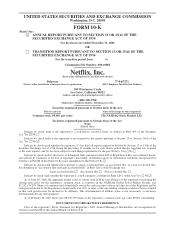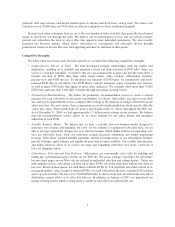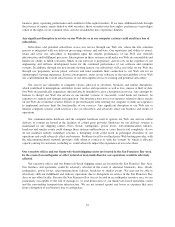NetFlix 2006 Annual Report Download - page 17
Download and view the complete annual report
Please find page 17 of the 2006 NetFlix annual report below. You can navigate through the pages in the report by either clicking on the pages listed below, or by using the keyword search tool below to find specific information within the annual report.Item 1A. Risk Factors
If any of the following risks actually occurs, our business, financial condition and results of operations
could be harmed. In that case, the trading price of our common stock could decline, and you could lose all or
part of your investment.
Risks Related to Our Business
If our efforts to attract subscribers are not successful, our revenues will be adversely affected.
We must continue to attract new subscribers. To succeed, we must continue to attract a large number of
subscribers who have traditionally used video retailers, video rental outlets, cable channels, such as HBO and
Showtime, pay-per-view and VOD for in-home filmed entertainment. In addition, we face direct competition to
our service, namely from services like Blockbuster Online, that will likely impact our ability to attract
subscribers. Our ability to attract subscribers will depend in part on our ability to consistently provide our
subscribers with a valuable and quality experience for selecting, viewing, receiving and returning titles, including
providing accurate recommendations through our recommendation service. Furthermore, the relative service
levels, pricing and related features of competitors to our service may adversely impact our ability to attract
subscribers. If consumers do not perceive our service offering to be of value, or if we introduce new services that
are not favorably received by them, we may not be able to attract subscribers. In addition, many of our new
subscribers originate from word-of-mouth advertising and referrals from existing subscribers. If our efforts to
satisfy our existing subscribers are not successful, we may not be able to attract new subscribers, and as a result,
our revenues will be adversely affected.
If we experience excessive rates of churn, our revenues and business will be harmed.
We must minimize the rate of loss of existing subscribers while adding new subscribers. Subscribers cancel
their subscription to our service for many reasons, including a perception that they do not use the service
sufficiently, delivery takes too long, the service is a poor value, competitive services provide a better value and/
or experience and customer service issues are not satisfactorily resolved. We must continually add new
subscribers both to replace subscribers who cancel and to grow our business beyond our current subscriber base.
If too many of our subscribers cancel our service, or if we are unable to attract new subscribers in numbers
sufficient to grow our business, our operating results will be adversely affected. If we are unable to successfully
compete with current and new competitors in both retaining our existing subscribers and attracting new
subscribers, our churn will likely increase and our business will be adversely affected. Further, if excessive
numbers of subscribers cancel our service, we may be required to incur significantly higher marketing
expenditures than we currently anticipate to replace these subscribers with new subscribers.
If we are unable to compete effectively, our business will be adversely affected.
The market for in-home filmed entertainment is intensely competitive and subject to rapid change. New
technologies for delivery of in-home filmed entertainment, such as VOD and digital delivery of content over the
Internet, continue to receive considerable media and investor attention. Many of our competitors have longer
operating histories, larger customer bases, greater brand recognition and significantly greater financial, marketing
and other resources than we do. The rapid growth of our online entertainment subscription business since our
inception may continue to attract direct competition from larger companies with significantly greater financial
resources and national brand recognition. We could also face competition from potential new entrants into the
online DVD rental or movie download markets. For example, we have seen the entry of direct competition from
Blockbuster, which launched its online service in August 2004 and continues to augment its online offering with
differentiated services, such as its Total Access program, which allows customers to exchange online rentals with
in-store rentals. In addition, Apple’s video iPod, Amazon’s Unbox, Wal-Mart’s DVD download offerings and
announcements from other companies ranging from Google and Yahoo! to Microsoft and Intel regarding their
efforts in digital delivery of content highlight the extremely dynamic environment in which we operate our
9
























